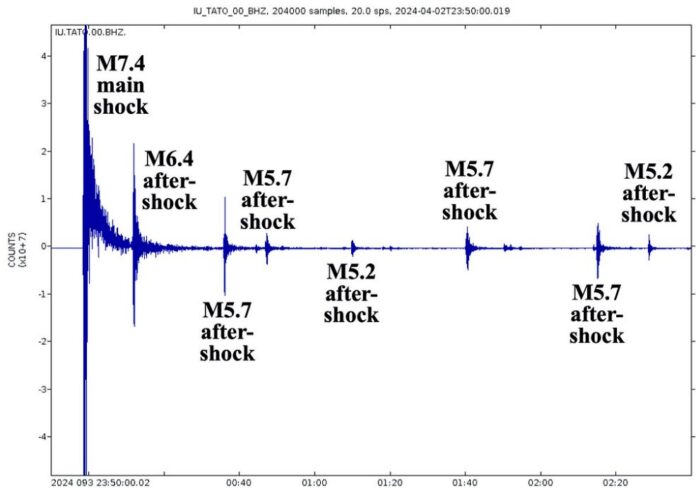The death toll from the Taiwan’s 7.4 quake near Hualien City on Wednesday remains at 7, but it could have been much worse.
It was the worst to hit the island in a quarter century, but its earthquake preparation initiatives is recovering “remarkably unscathed.”
The earthquake injured over 1,000 people and at least caused 100 people to be trapped, as of Thursday, NBC News reported. This compares to the 1999 Chi-Chi earthquake with a 7.3 magnitude, where thousands more died and over 100,000 buildings collapsed.
“Two thousand four hundred people died [in 1999]. And this time, we only have nine people reported dead. You see the progress,” said Larry Syu-Heng Lai, a geologist and postdoctoral researcher at the University of Washington who grew up and studied in Taiwan, to NBC News. “Our buildings are stronger. Our facilities are better. You can say we take it seriously — but it’s part of life every day.”
After the 1999 earthquake, Taiwan faced governmental criticism for lacking building codes and poor quality materials, NPR reported.
To better equip the island for seismic activity, the Taiwanese government set up a robust early-warning system (though the system malfunctioned on Wednesday) and improved modern seismic building codes to upgrade the country’s infrastructure, according to NPR.
“It is quite remarkable that given an earthquake of this magnitude, we have seen so few reported causalities,” said Daniel Aldrich, a political science professor at Northeastern University who studies earthquake resilience globally, to NPR. “India and Haiti faced less powerful earthquakes but had far more casualties and Taiwan has managed to have so few.”
Every year, the island of Taiwan experiences more than 2,000 small quakes a year, with the majority being minimal and unnoticed by people, NPR noted. However, the country sits on some of the biggest fault lines, making it essential for these earthquake preparedness protocols.
“Taiwan has invested a lot of time and resources to make infrastructure more resilient to earthquakes,” said Trevor Carey, a civil engineering professor at the University of British Columbia who traveled to Taiwan after the 2022 earthquakes, to NPR. “The team saw a lot of things that confirmed newer or updated infrastructure or retrofits did better during an earthquake, and older non-retrofitted [buildings] did not do as well.”
Taiwan’s earthquake preparedness initiatives made experts in the U.S. to evaluate their own earthquake services in quake-prone cities.
“Seattle isn’t doing as much to prepare — or Portland — as Los Angeles or San Francisco. And neither are doing as much to prepare as Taipei,” said Harold Tobin, the director of the Pacific Northwest Seismic Network and a professor at the University of Washington, to NBC News.
“These events always give us information to evaluate how well we’re doing here in California,” said John Wallace, a professor of civil and environmental engineering at the University of California, Los Angeles, to NBC News.
AsAmNews is published by the non-profit, Asian American Media Inc.
We’re now on BlueSky. You can now keep up with the latest AAPI news there and on Instagram, TikTok, Facebook, YouTube and X.
We are supported by generous donations from our readers and by such charitable foundations as the Robert Wood Johnson Foundation.
You can make your tax-deductible donations here via credit card, debit card, Apple Pay, Google Pay, PayPal and Venmo. Stock donations and donations via DAFs are also welcomed.
Suggested photo: https://commons.wikimedia.org/wiki/File:2018_Earthquake_In_Hualien_City_Taiwan_(245591057).jpeg (Caption: In 2018, an earthquake of magnitude 6.4 hit Taiwan’s Hualien City.) ––– OR ––– https://commons.wikimedia.org/wiki/File:Taipei_Taiwan_Republic-of-China-Military-Officers-Club-01.jpg
Suggested slug: earthquake-taiwan-island-disaster-injuries-emergency-destruction-search-rescue


